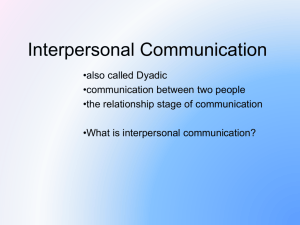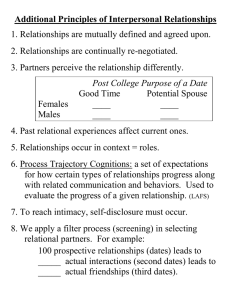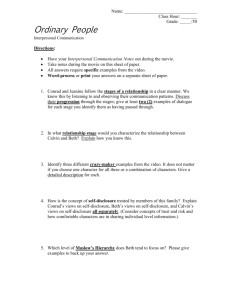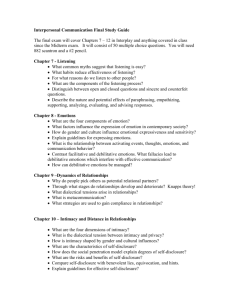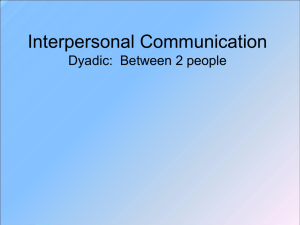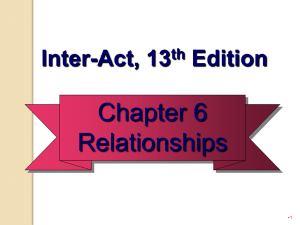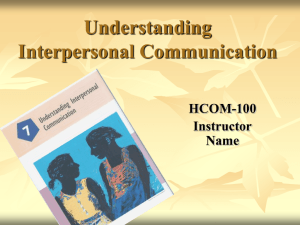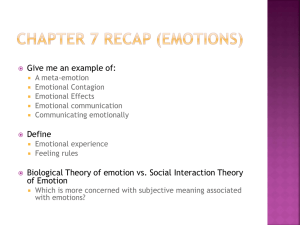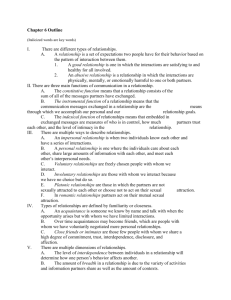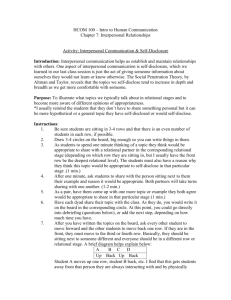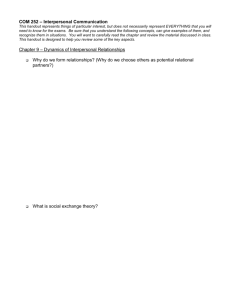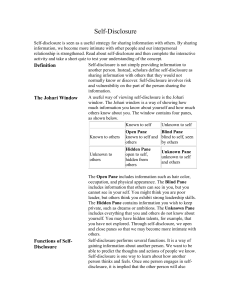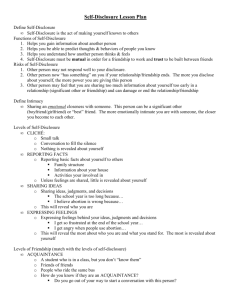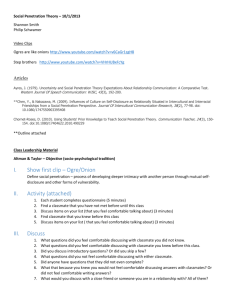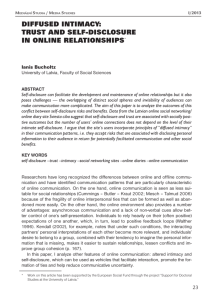Handout 7 - Anna Kuzio's Website
advertisement
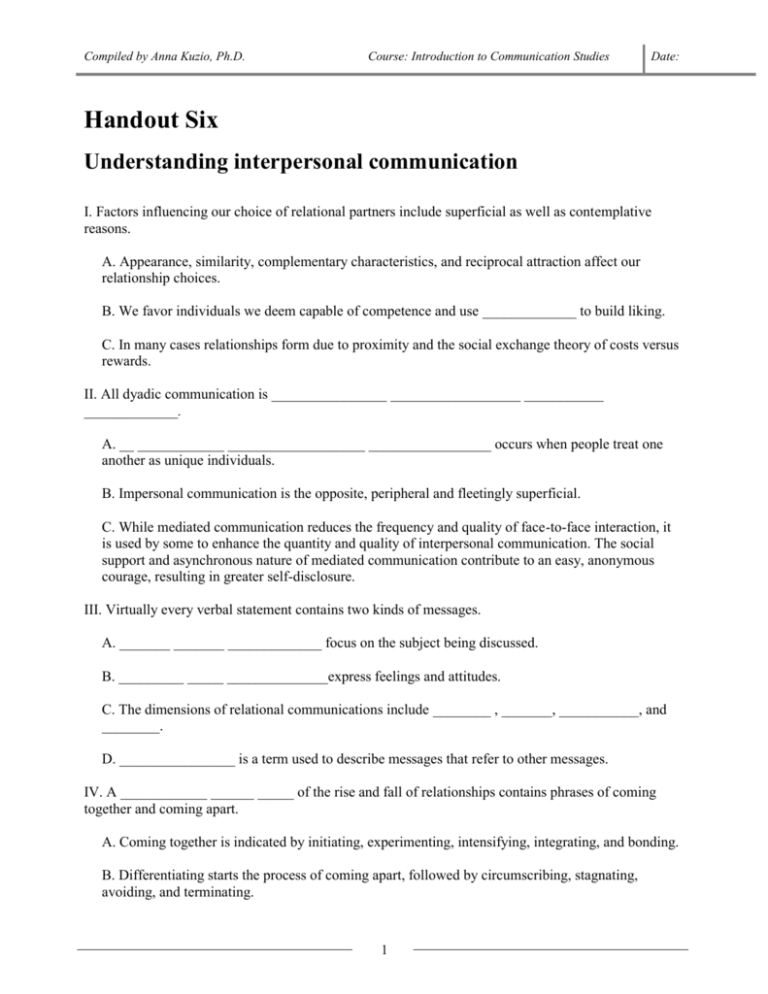
Compiled by Anna Kuzio, Ph.D. Course: Introduction to Communication Studies Date: Handout Six Understanding interpersonal communication I. Factors influencing our choice of relational partners include superficial as well as contemplative reasons. A. Appearance, similarity, complementary characteristics, and reciprocal attraction affect our relationship choices. B. We favor individuals we deem capable of competence and use _____________ to build liking. C. In many cases relationships form due to proximity and the social exchange theory of costs versus rewards. II. All dyadic communication is ________________ __________________ ___________ _____________. A. __ ____________ ___________________ _________________ occurs when people treat one another as unique individuals. B. Impersonal communication is the opposite, peripheral and fleetingly superficial. C. While mediated communication reduces the frequency and quality of face-to-face interaction, it is used by some to enhance the quantity and quality of interpersonal communication. The social support and asynchronous nature of mediated communication contribute to an easy, anonymous courage, resulting in greater self-disclosure. III. Virtually every verbal statement contains two kinds of messages. A. _______ _______ _____________ focus on the subject being discussed. B. _________ _____ ______________express feelings and attitudes. C. The dimensions of relational communications include ________ , _______, ___________, and ________. D. ________________ is a term used to describe messages that refer to other messages. IV. A ____________ ______ _____ of the rise and fall of relationships contains phrases of coming together and coming apart. A. Coming together is indicated by initiating, experimenting, intensifying, integrating, and bonding. B. Differentiating starts the process of coming apart, followed by circumscribing, stagnating, avoiding, and terminating. 1 Compiled by Anna Kuzio, Ph.D. Course: Introduction to Communication Studies Date: C. Not all relationships follow all the progressive steps, and they usually are fluid and transitory between the stages. V. Seeking important but often incompatible goals in a relationship results in a ___________ ______ _____ that demonstrates the creation of __________ _________. A. These tensions include a connection–autonomy dialectic, a predictability–novelty dialectic, and an openness–privacy dialectic that requires agile juggling. B. Managing these dialectical tensions requires the strategy of recognizing denial, overcoming disorientation, using a selection process for the alteration between one end or the other, compartmentalizing different areas in a segmentation tactic, using moderation or compromise to handle the tension, and reframing that could result in reaffirmation. VI. Even the closest relationships involve a mixture of alternating “we” with “me.” A. _________ is defined as a close union, contact, association, or acquaintance. B. Physical closeness, intellectual sharing, emotion involving an exchange of important feeling, and shared activities provide various states of intimacy. C. Women appear more willing to share their thoughts and feelings, and cherish personal talk. Men grow close to one another by doing things together. Generally speaking, men value doing for or with as intimacy. D. Personal preferences influence intimacy styles more than gender. People typically orient to either words of affirmation, quality time, acts of service, gifts, or physical touch. E. Cultural variances affect how much intimacy is desired. VII. The process of deliberately revealing information about oneself that is significant and that would not normally be known is called self-disclosure. A. The _____ ___________ _______ has as its first dimension the _______ of information volunteered. This includes the range of subjects discussed. The second dimension is the ______ of shifting from non-revealing to personal messages. B. Another model of self-disclosure is reflected in the _______ ______, where your likes and dislikes, goals, secrets, and needs are then divided into a part you know about and the part you don’t know about imposed one atop the other with things others know about you and things you want to keep to yourself. There is an open area and a blind area, a hidden area and an unknown area, and items move from one area to the other through self-disclosure. C. Self-disclosure is influenced by culture and usually occurs in dyads. It is usually symmetrical and occurs incrementally. While relatively scarce, self-disclosure uses the guidelines of: is the person important to you, is the risk reasonable, is it appropriate, will it be reciprocated, and is it constructive, clear, and understandable? VIII. Three common alternatives to self-disclosure are lies, equivocation, and hinting. 2 Compiled by Anna Kuzio, Ph.D. Course: Introduction to Communication Studies Date: A. __________ _____ ____ are defined as intended to be harmless or even helpful. Yet the discovery of lies causes feelings of dismay and betrayal. B. Equivocation has perceived value as a balance between harsh truths and lying. C. Hints are more direct than ________ ________ but depend on the other person’s ability to pick up the unexpressed message. Word Bank affinity breadth contextually interpersonal communication depth dialectical model equivocal language intimacy metacommunication relational message self-disclosure altruistic lies content messages control developmental models dialectical tensions immediacy Johari Window qualitatively interpersonal communication respect social penetration model Homework Select a relationship that is important to you. Analyze the relationship in terms of the following three dialectic tensions: 1. Connection versus autonomy 2. Predictability versus novelty 3. Openness versus privacy 3

